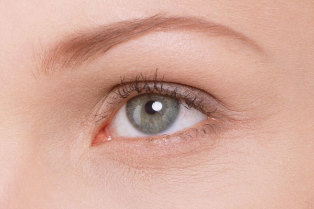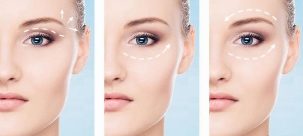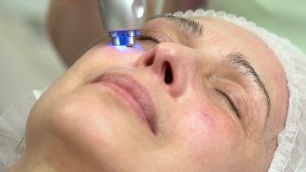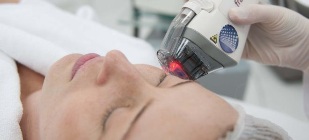
Eyelid lifting is a complex hardware, injection and manual operation, designed to restore and model the area around the orbit (the area around the eyes). This part of the face is considered an area of increased sensitivity, so even for highly qualified specialists with extensive experience, non-surgical aesthetics eyelid correction is a difficult task. Nowadays, microsurgical cosmetology and aesthetic medicine provide several effective methods to lift the eyelids: radio wave lifting, bio-enhanced thread, contour shaping, photorejuvenation, and micro-current therapy. Only after visual inspection of the problem area and studying the patient’s medical history, goals and final results can the most appropriate technique be selected.
Features of periorbital elevation
The area of the eyelid, also known as the periorbital area (because of the eyelid fissure, eyelid fissure and conjunctival sac, besides the eyelid, it also belongs to the periorbital space, which is not completely correct), is one of the most sensitive areas of the human bodyFirst, the dermis is thin and the cortex has very small subcutaneous fat. The eyelids are folds of muscle skin, surrounded by conjunctiva and cartilage tissue. They are located around the eyes and perform multiple functions immediately: they protect the cornea and retina from the adverse effects of environmental factors (ultraviolet radiation, dust, etc. ), clean the connective tissue membrane due to constant wetting with tear fluid, prevent dry scleraAnd cornea.
prevent dry scleraAnd cornea.
The skin of the eyelid area is several times thinner than the skin of other parts of the face, so it is more prone to age-related pressure changes, which become obvious after 30 years of age. At this age, the body begins to become dehydrated naturally, as a result, the epidermal cells lose moisture, the skin loses its elasticity, and becomes loose and loose. The first signs of aging are formed in the periorbital area of men and women over 30 years of age: hypodynamic wrinkles, mimic wrinkles, wrinkling of the outer corners of the eyes ("crow's feet").
Lifting the eyelid is a complicated task, which can only be performed by a qualified doctor with good knowledge of ocular anatomy, because incorrect actions will not only cause new defects, but also seriously damage the function of the visual organs. The fact is that the eyelids are involved in the formation of the cornea and the optical geometry of the cornea as well as the adjustment of intraocular pressure. Therefore, improper plastic surgery and lifting surgery may cause visual dysfunction (irreversible in some cases).
Who needs to lift the eyelid
- The protrusion of the supraorbital fold;
- Excessive skin at the skin folds of the infraorbital muscles;
- The outer corners of the eyes are drooping;
- Periorbital protrusion (fatty hernia);
- Periorbital edema (cyst);
- Vascular disease causes rosacea and dark circles under the eyes;
- Low dynamic wrinkles;
- "Crow's feet" (wrinkles around the eyes);
- Strongly prominent infraorbital groove;
- "Eyelid aging" (atrophy and sagging of the eyelid skin).
Eyelid lifting can also help create a fresher and more open appearance by correcting overhanging skin and fat pockets around the eye sockets and improving the overall tone of the area. Timely use of various methods to rejuvenate the area around the eye helps to solve one of the main tasks of periorbital lifting-hiding age-related changes in the skin and eliminating dermal organisms in the background of reduced epidermal cell functional potentialThe visual defects of aging.
Timely use of various methods to rejuvenate the area around the eye helps to solve one of the main tasks of periorbital lifting-hiding age-related changes in the skin and eliminating dermal organisms in the background of reduced epidermal cell functional potentialThe visual defects of aging.
Important! The aging and heaviness of the eyelids is a pretty serious aesthetic defect that can even destroy a young and charming face. For some people, signs of skin aging in this area may even appear before the age of thirty (for example, underweight patients or patients with endocrine system diseases). Generally, cosmetics are ineffective in correcting existing problems and are only suitable for preventing premature aging. Therefore, the only effective way to solve this defect is periorbital lifting.
Eyelid Lifting Surgery
The operation of lifting the skin of the upper and lower eyelids is called blepharoplasty. This is a fundamental improvement in the area around the orbit, in which, by completely removing excess skin and fatty hernias in the eyelid area, a firming and rejuvenating effect can be achieved. Unlike non-surgical lifting of the eyelids, eyelid plastic surgery can not only correct the defects of skin aging and improve the appearance of the area, but also correct the shape and shape of the eyes and get rid of various diseases.
Unlike non-surgical lifting of the eyelids, eyelid plastic surgery can not only correct the defects of skin aging and improve the appearance of the area, but also correct the shape and shape of the eyes and get rid of various diseases.
Blepharoplasty is effective for serious eye diseases, such as entropy (eyelashes bulging and the edge of the eyelids bulging toward the eyeball) or exophthalmos (eyeball moving out of the eye socket). In general, blepharoplasty is divided into three types: upper, lower and round.
table. Types of periorbital radical resection
| Operation type | Cross-sectional area | Which pathologies can be corrected |
|---|---|---|
| supraorbital blepharoplasty | A skin incision made along the fold of the eye socket or eyelid margin of the upper eyelid. | Remove excess skin, subcutaneous fat and muscle glue. |
| Infraorbital blepharoplasty | Make a percutaneous or ciliary incision. | Eliminate orbital edema, eye bags, and fatty hernia. |
| Circular blepharoplasty | Simultaneous eyelid surgery on both sides. | Solve the common problems of all types of blepharoplasty. |
Surgery for tightening the periorbital area is strictly performed in the hospital, excluding the possibility of outpatient surgery. The patients were given general anesthesia, and the average intervention time was about 3 hours. A significant disadvantage of this method of lifting the eyelids is the postoperative period. Although the duration is short (about two weeks), it is characterized by pain, the need for regular bandaging and antiseptic treatment, and significant restrictions on treatment options and professional activities.
Important! The advantage of blepharoplasty is that it can not only tighten the skin of the eyelids, but also can perform plastic surgery on the muscle tissue, which is impossible to achieve using hardware and other minimally invasive methods.
Tighten the peritoneal area without surgery
Eyelid surgery is a very effective method that can completely rejuvenate the area around the eyes, but experts suggest that it is only for older people (after 40) with obvious signs of aging and age-related skin changesThis method can only be used in patients with signs of disease. Before reaching this age, although the fluid mechanics of the tissue is within the normal range, there are many less invasive methods that can solve existing problems, and in some cases, the effectiveness of most of these techniques can be compared with the results of surgical plastic surgery. Compare.
Injection (contour) plastic
Depending on the technique that is part of the isothermal treatment procedure, contouring may be the safest non-surgical eyelid skin tightening method. The contour line is a subcutaneous injection of a special implant called a filler.
These are preparations in the form of homogeneous and viscous suspensions or gels, the ingredients of which have a high affinity for the body's own tissues. These can be:
- Hyaluronic acid;
- Calcium hydroxyapatite;
- Collagen (a peptide synthesized by fibroblasts, which is one of the main elements of the extracellular substance of the dermis, which can ensure its elasticity and stretch ability);
- Polymers based on acrylic acid and methacrylic acid;
- Oxidized high molecular weight silicone;
- Polylactic acid;
- Tripolyphosphate etc.
The most popular and most needed filler for orbital lifting is hyaluronic acid-based formulations. These are biodegradable (absorbable) dermal implants that can not only compensate for the lack of tissue in the area, but also eliminate wrinkles-wrinkles are one of the main visual signs of facial aging. The advantages of hyaluronic acid fillers include a high degree of hypoallergenicity and excellent effects, which can be realized immediately after implantation. The bioabsorption of hyaluronic acid will occur within a few weeks, after which the injection must be repeated.
Biosynthetic implants based on polylactic acid and calcium hydroxyapatite can maintain their properties for 1-2 years.
RF boost
Radio wave or radio frequency lifting is a non-surgical lifting of the area around the eye and has a high effect. In the hardware technology of minimally invasive lifting of the upper and lower eyelid skin, RF lifting technology is in a leading position, because it can not only achieve an immediate tightening effect, but also significantly improve the skin condition in the periorbital area.
In the hardware technology of minimally invasive lifting of the upper and lower eyelid skin, RF lifting technology is in a leading position, because it can not only achieve an immediate tightening effect, but also significantly improve the skin condition in the periorbital area.
Radio waves penetrate into the dermis to the desired depth, heating the epidermal cells to a collagen densification temperature of approximately 60 degrees Celsius. Under the action of heat energy, the dermal tissue heats up and the collagen framework partially shrinks. As a result, the loose collagen fibers shrink again and take on its unique spiral shape, which is the lifting effect.
RF lifting is suitable for correcting all age-related problems in the area around the eyes (crow's feet, hypodynamic wrinkles, drooping eyelids, etc. ), and the effect can last up to 1-2 years. In order to obtain a stable rejuvenation effect, you will need to perform about 6-10 steps, at least 7-10 days apart.
Threaded biological enhancement (thread lift)
Thread lift is a procedure to rejuvenate the area around the eyes by implanting a special cosmetic thread made of a variety of metals and synthetic materials under the skin. As a result, new collagen is formed in the subcutaneous layerskeleton. This procedure is very effective and can help you cope with other phenomena such as "ageing century", periorbital fatty hernia, gravitational sagging phenomenon and skin aging.
There are several types of threads used to promote threads. The beauty industry is in great need of threads made of precious metals. These threads are made of platinum or gold and are designed to reinforce the upper layer of leather. The gold thread not only provides a visible lifting effect, but also stimulates cell metabolism, thereby improving the supply of nutrients, oxygen and vitamins to the dermal cells. The serious disadvantage of threads made of precious metals is the high risk of shedding and the inability to use many modification procedures, such as photopyrolysis after enhancement.
The liquid centerline is mainly used to combat small hypodynamic folds, correct "aging eyelids" and smooth the skin around the orbit. The duration of this process does not exceed 20-30 minutes, but there are many contraindications to liquid reinforcement, and it is always accompanied by various side effects (swelling, bruising, redness). Experts believe that the most effective types of eyelid thread lifting are Swiss thread, polylactic acid thread and Korean thread. The result after reinforcement lasts about 2-3 years.
Partial photopyrolysis
Partial photopyrolysis is another effective non-surgical way to tighten the upper and lower eyelids. This is a laser renaissance in which a fractional laser generator (for example, a laser laser) is used to affect the problem area. The light beam generated by the device is scattered into many beams. When it hits the skin, it will form a large number of micro-thermal healing areas, which play a major role, so the surrounding tissue will not become hot and will not be hurt.
tissue will not become hot and will not be hurt.
A unique feature, the main principle of simultaneous partial photothermal decomposition is to heat the skin to a temperature of 250-300°C, which experts call an evaporation process. Under the influence of this temperature, the ancient, pathologically altered and destroyed cells are destroyed and evaporated, while the natural new collagen is activated, and the activity of fibroblasts increases, thereby synthesizing the main component of the extracellular matrix-peptide (collagen)And elastin).
The result of laser partial resurfacing is that the eyelid skin is significantly tightened, wrinkles and wrinkles are smoothed, the fluid dynamics of the periorbital tissues are restored, and the overall condition of the skin in the area is improved.
Pulse current (micro current)
Microcurrent therapy refers to a low-invasive method of lifting the eyelids, but the significant disadvantage of this method is the short duration of results (no more than 4 months). The clinical outcome of micro-current therapy in improving the periorbital area is attributed to the following characteristics of pulsed current:- Normalization of lymphatic drainage.Lymphatic drainage can generate pulse currents on the skin, improve lymphatic movement, prevent it from stagnating, and help reduce dark circles under the eyes;
- Stimulate the metabolic process.The activation of cell metabolism has a positive effect on the transport of oxygen and nutrients and the appearance of the skin (skin becomes smooth and obtains a healthy appearance);
- Restore muscle tone.The muscles of the eyelids are very weak, and additional stimulation can make you tighten.
The standard course duration is 10 to 20 courses, and in most cases, it is necessary to repeat the course after a few months.

Before and after the photo
Conclusion
Lifting the eyelid is a difficult task, but it is also a feasible task. To this end, modern aesthetic medicine provides many effective methods, including solutions with low traumatic operations and low complication rates. After talking with the patient, diagnosing the problem area and studying the medical history data, respectively decide which orbital lifting method is the most effective and safest.
The use of surgical techniques is mainly used for patients with obvious signs of aging in the area around the eyes. In these patients, the use of gentle techniques is ineffective and may not produce stable positive results. People with the initial manifestations of the "ageing century" are best to choose minimally invasive methods with low tissue trauma and short recovery period.
























































